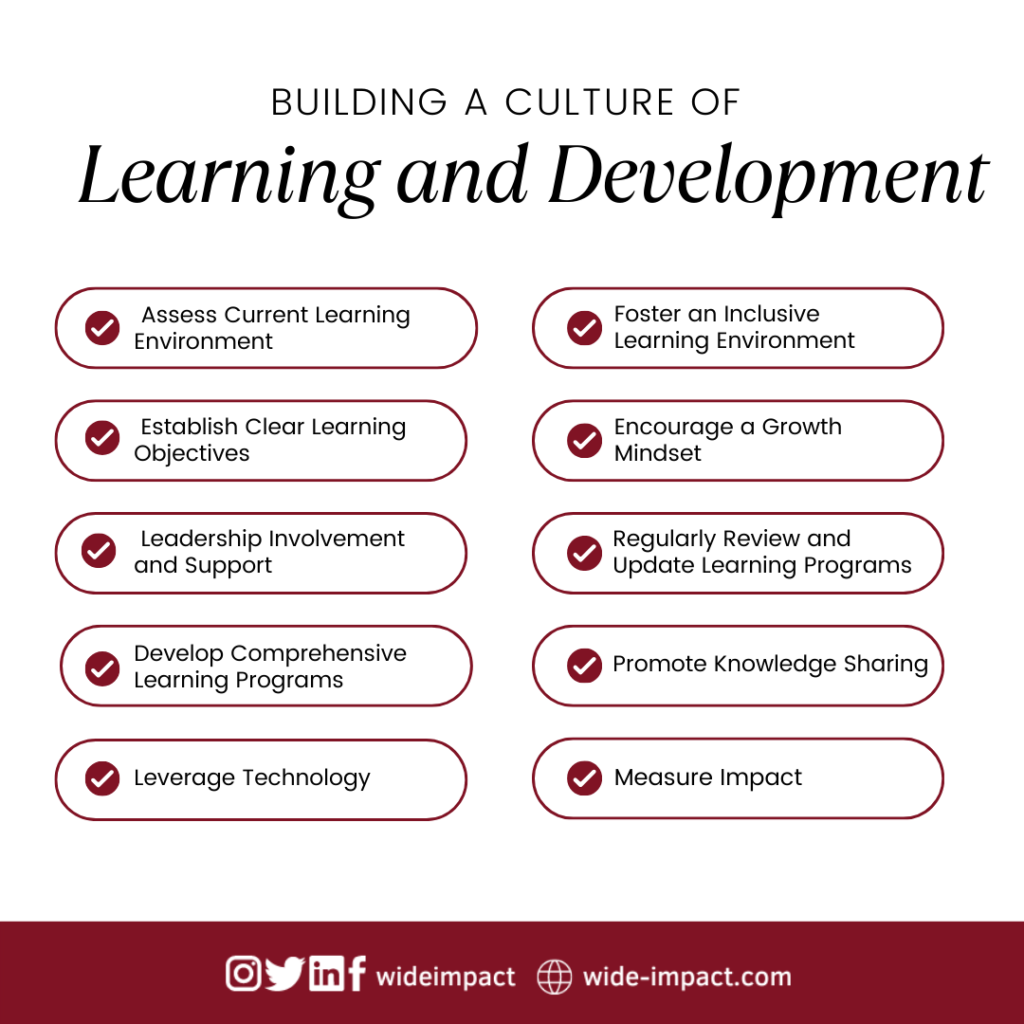By Dr. Salam Slim Saad
Early in my career, I had the opportunity to work for a company that was highly regarded for its dynamic and innovative approach. This company was deeply committed to fostering a culture of continuous learning and development, and I quickly learned the profound impact such a culture can have on both individual and organizational success. Right from the start, employees were encouraged to pursue their passions, enhance their skills, and contribute their creativity to the company’s growth.
This experience was transformative for me, shaping my understanding of how crucial a culture of learning and development is to achieve organizational excellence. In this exploration I aim to share insights and strategies on how organizations can cultivate an environment that promotes continuous learning, driving their progress and success in today’s rapidly evolving business landscape.
The Advantages of a Learning and Development Culture
A culture of learning and development in the workplace offers numerous benefits, touching all facets of an organization.
Firstly, it significantly boosts employee engagement and motivation. When employees have access to continuous learning opportunities, they feel valued and empowered, which enhances job satisfaction and efficiency. This, in turn, can lead to reduced staff turnover and better retention of top talent.
Innovation is another critical advantage. Encouraging employees to gain new skills and stay current with industry trends creates an atmosphere conducive to innovative thinking. This environment is ideal for generating new ideas and improving problem-solving capabilities.
Moreover, investing in staff development has a direct and positive impact on organizational performance. When employees grow their knowledge and abilities through training or workshops, they contribute more effectively to their roles. This not only benefits individual job performance but also enhances team collaboration and the company’s overall productivity.
A culture of learning also makes an organization more adaptable. In a business world characterized by constant change, having a workforce that is proactive and ready to adapt is crucial. A mindset focused on continual growth equips employees to manage and embrace change with confidence.
Lastly, emphasizing professional development during the recruitment process attracts high-caliber candidates. Job seekers increasingly look for companies that support their professional growth and development.
Case Studies of Successful Companies with a Strong Culture of Learning and Development
Let’s take a closer look at some real-world examples of companies that have successfully built a culture of learning and development within their organizations. These case studies serve as inspiration for other businesses looking to create similar environments where employees can thrive.
Google, for instance, has established numerous programs to encourage continuous learning among its employees. From offering online courses on a variety of subjects to promoting employee-led training sessions, Google emphasizes the importance of knowledge sharing and personal development.
Zappos, the online shoe and clothing retailer known for exceptional customer service, provides extensive training opportunities for new hires, including an intensive four-week program called “Zappos Insights.” This immersive experience allows employees to learn about the company’s culture while developing essential skills in areas like leadership and
Salesforce has also focused on learning and development with its Trailhead platform, offering interactive learning modules that enable employees to gain new skills at their own pace, with the added benefit of earning badges and certifications that can lead to career advancement.
These examples illustrate the tangible outcomes of nurturing a learning culture, including increased employee engagement, improved performance, heightened innovation, and reduced turnover. By prioritizing their employees’ growth, these companies have established themselves as leaders in their fields.
Implementing a Learning and Development Culture
Establishing a culture of learning and development is essential for sustained growth and innovation. Here are some foundational steps for building such a culture:
- Define the Vision: Clearly articulate why learning and development are critical and how they align with the company’s overall objectives.
- Leadership Commitment: Ensure top-level management is on board, as their endorsement is crucial for driving change and setting a precedent for the entire organization.
- Assess Learning Needs: Identify skill gaps and areas that require further development to design targeted training programs.
- Provide Resources: Dedicate adequate financial and human resources to support learning initiatives, including tools, technologies, and expert personnel.
- Encourage Collaboration: Promote a culture where employees can share knowledge and experiences, enhancing the learning environment.
- Celebrate Successes: Recognize individuals or teams that demonstrate significant progress in their development, underscoring the importance of continuous learning.
- Evaluate Progress: Regularly measure the effectiveness of learning programs and adjust strategies based on feedback to ensure they meet the evolving needs of the organization.
Resources for Cultivating Learning and Development
- Assess Learning Needs: Identify skill gaps and areas that require further development to design targeted training programs.
- Implementing a culture of learning and development can be complex, but various tools and resources can aid in the process:
- Learning Management System (LMS): An LMS is vital for organizing, delivering, and tracking training programs. It allows employees flexible access to courses, suiting their schedules and learning preferences.
- E-learning Content: This encompasses online courses, webinars, videos, and articles on various topics. Offering a range of content types caters to different learning styles.
- Mentoring Programs: These programs are key for ongoing learning, pairing experienced employees with newer ones for knowledge transfer, guidance, and feedback.
- Collaboration Platforms: Such platforms encourage knowledge sharing and collaboration across departments, enhancing the learning environment.
Additionally, several other factors are crucial for fostering this culture:
- Supportive Leadership: Leaders who value learning and development are essential in establishing this culture.
- Dedicated Training Budget: Allocating funds for training initiatives shows a commitment to employee development.
- Time for Professional Development: Setting aside specific times for training encourages continuous learning.
- Open-Door Policy: Creating an atmosphere where employees can freely discuss their development needs builds trust.
- Rewarding Learning Achievements: Recognizing and rewarding learning efforts underlines its importance.
Overcoming Obstacles to Learning and Development
Building a culture of learning comes with its challenges:
- Resistance to Change: Some employees may be comfortable with the status quo and hesitant to embrace new learning initiatives.
- Lack of Leadership Support: Without leadership endorsement, it can be difficult to establish a learning culture.
- Resource Constraints: Limited budgets and tools can impede the development of a learning environment.
- Time Management: Employees may struggle to find time for development amidst their regular work duties.
Sustaining a Culture of Learning for Organizational Excellence
To ensure the longevity of a learning culture, it is vital to integrate it into the company’s ethos:
- Leadership Support: Leaders should actively engage in and advocate for continuous learning.
- Embed Learning into Processes: Make learning a natural part of the workflow, such as in onboarding and project reviews.
- Foster Collaboration: Encourage the sharing of knowledge and expertise across the company.
- Recognize Achievements: Celebrate learning milestones to emphasize their value within the company.
- Adapt with Technology: Stay abreast of and incorporate tech advancements that facilitate learning.
- Create Feedback Loops: Allow employees to give input on and influence the direction of learning initiatives.
- Measure Impact: Use data to evaluate the effectiveness of training and refine programs accordingly.
We began this discussion by highlighting the significance of a culture of learning and development in achieving organizational excellence. My early career experience in a company that valued such a culture showcased how it could amplify individual competencies and contribute to the company’s overall growth.

However, establishing this culture is not without challenges. These include resistance to change, limited resources, and lack of support from leadership. Overcoming these barriers is crucial for the successful implementation of learning and development strategies, which are essential for employee growth and organizational performance.
To foster a learning culture, organizations must adopt a structured approach, providing resources, creating learning-friendly environments, and ensuring leadership support. By embedding learning into the organization’s culture, companies can unlock their employees’ potential, leading to improved performance, innovation, and a competitive edge in the market.
In closing, cultivating a culture of learning and development is a strategic and necessary endeavor for organizational excellence. By addressing challenges and implementing solutions that prioritize continuous learning and employee growth, organizations pave the way for sustainable success. This commitment benefits not only the employees in terms of skill enhancement and job satisfaction but also significantly contributes to the organization’s adaptability and prosperity in an ever-evolving business landscape.



